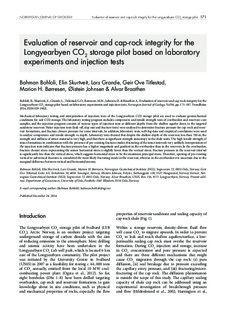| dc.description.abstract | Mechanical laboratory testing and interpretation of injection tests of the Longyearbyen CO2 storage pilot are used to evaluate geomechanical
conditions for safe CO2 storage. The laboratory testing program includes compressive and tensile strength tests of overburden and reservoir core
samples, and the injection program consists of various types of injection tests at different depths from the shallow aquifer down to the targeted
sandstone reservoir. Water injection tests (leak-off, step rate and fracture tests) were analysed to determine fracture pressure for cap-rock and reservoir
formations, and fracture closure pressure for some intervals. In addition, laboratory tests, well-log data and empirical correlations were used
to analyse compressive and tensile strength vs. depth. Laboratory tests showed that despite the shallow depth of the reservoir, less than 700 m, the
strength and stiffness of intact material is very high, and that there is significant strength anisotropy in the shale units. The high tensile strength of
intact formations in combination with the presence of pre-existing fractures makes fracturing of the intact intervals very unlikely. Interpretation of
the injection tests indicates that fracture pressure has a higher magnitude and gradient in the overburden than in the reservoir. In the overburden,
fracture closure stress representing the minor horizontal stress is slightly lower than the vertical stress. Fracture pressure in the reservoir interval
is significantly less than the vertical stress, which suggests horizontal stress to be the minimum principal stress. Therefore, opening of pre-existing
vertical to subvertical fractures is considered the most likely fracturing mode in the reservoir, whereas in the overburden it is uncertain due to the
marginal difference between vertical and horizontal stresses. | |
